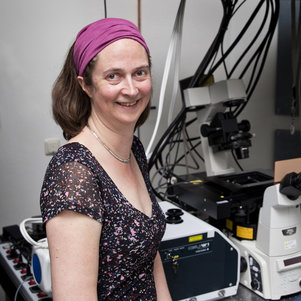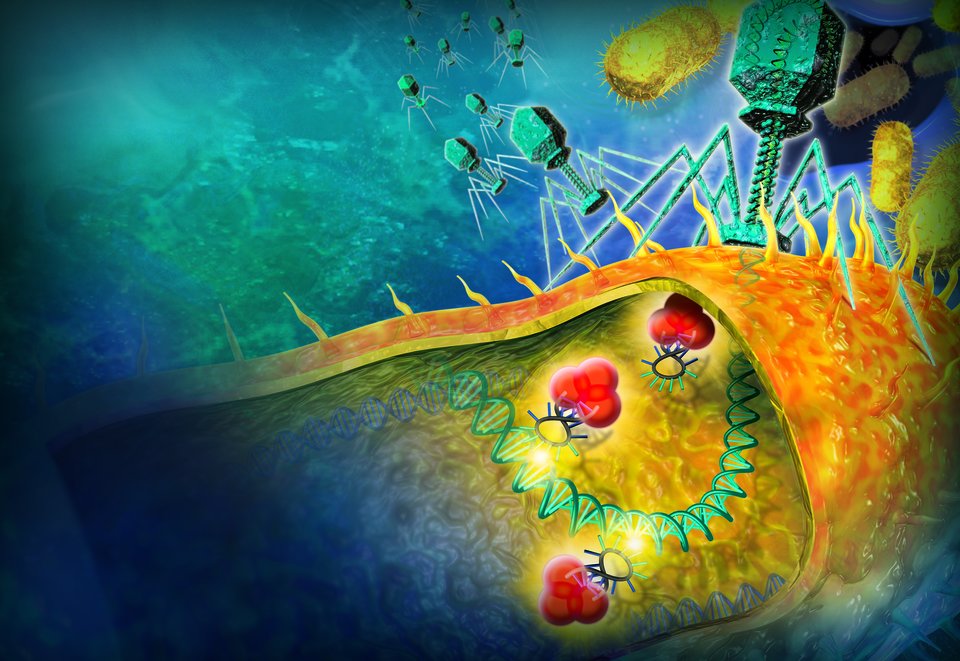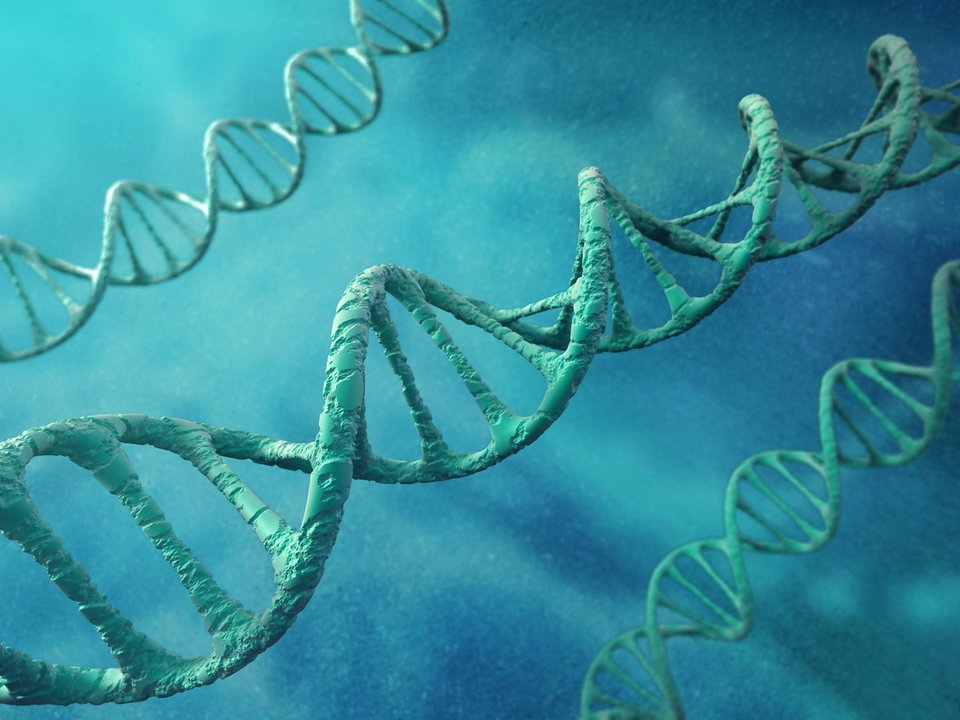Scientists across the world are conducting research into cells. But, despite all of their efforts, cells still harbour many secrets. However mind-blowingly complex cells may be, though, increasing numbers of scientists are starting to believe that it should be possible to construct a cell from separate building blocks, one step at a time. TU Delft has the knowledge to play a pioneering role in this process.
On one of the walls of Marileen Dogterom's office, head of the department of Bionanoscience in the Faculty of Applied Sciences, there is an enormous drawing of the interior of a cell, with swirling proteins in all shapes, colours and sizes. A long string of DNA winds its way through the clumps.
It is quite clear what the primary area of focus is here: the cell. But the research conducted in the department is about more than learning to understand how a cell works. The TU Delft scientists want to go a step further: they want to construct a synthetic cell, together with their counterparts in the Netherlands and abroad. The relatively young field of research that designs new biological systems using existing building blocks is referred to as ‘synthetic biology’. It is a specialist field that is clearly on the rise.
Borrowing principles
Marileen Dogterom herself primarily conducts research into the physical processes within cells. She addresses such questions as: ‘What forces play a role in processes within a cell?’ and ‘What is it that gives a cell its shape?’. A key area of Dogterom's expertise is microtubules. These are hollow protein tubes that form part of the framework of the cell, the so-called cytoskeleton. ‘We do not plan to precisely mimic any existing cell type,’ says the head of the department about the ambitious plan to create a synthetic cell. ‘Instead, we intend to borrow principles from simple systems such as yeasts or bacteria and then link them together.’
Borrowing principles and linking them together may sound simple, but there is still a lot to research and to learn, even about rudimentary biological systems. Research conducted by Craig Venter, the molecular biologist who became famous for being the first to sequence the human genome, confirms this. In 2010, Venter created what he described as a ‘synthetic life form’ by removing the contents of a bacterial cell, replacing it with DNA developed in the lab and bringing it back to life. It proved to be considerably more difficult than he thought it would be.
Minimal cell
In 2016, the same Craig Venter also presented a minimal cell. ‘Venter's group had taken a simple bacterium with a genome of around 1,000 genes and started taking bits out of it’, explains Dogterom. ‘After removing a piece of DNA, they would check to see if the cell was still functioning.’ By gradually shaving off the genetic material gene by gene, the group eventually discovered a minimum number of genes that the bacterium needed to keep itself alive. That magic number? 473 genes. Fewer than that and the cell no longer functioned.
Craig Venter's ‘minimal bacterium’ is interesting, but also slightly surprising. Because if you look at the separate components that experts believe are needed in order to construct a complete cell from the bottom up, and the genes that code for them, 473 seems like a very large amount.
Coordination and timing
Christophe Danelon , who also conducts research into synthetic cells with his group in Delft, says he is aiming for a ‘global approach’. Danelon: ‘We do not focus on a single component, but we attempt to construct the different modules we need simultaneously.’ Not so long ago, for example, Danelon's group succeeded in artificially synthesising phospholipids. These fatty chemicals form the ‘vesicles’ in which the other parts of the synthetic cell will soon have to do their work.
Danelon estimates that the components needed for a minimal cell can be made using approximately 150 genes, which is not even a third of Craig Venter's 473 genes. This therefore raises a question: will these 150 genes work together when they are combined into one singe strand of DNA? Danelon suspects that the genes in Venter's cell whose purpose is still unknown may be involved in such things as the coordination and timing of cellular processes. Ultimately, everything has to happen in the right sequence. For example, it makes no sense for a cell to start dividing if no copy has yet been made of the genetic material.
Cutting through the middle
Cees Dekker is the third leading TU Delft researcher involved in the project. Just like Marileen Dogterom, he has a strong physics background. The two scientists also share a refusal to be deterred by the complexity of the cell. ‘It is absolutely true that life is enormously complex’, says Dekker. ‘But does that mean we should say: it is so complicated, let's not even start? Or should we say instead: We see an opportunity to construct test systems and look at what we understand about them? The latter, in my view. I am a scientist because I want to understand how nature works.’
Dekker's group is focused on synthetic cell division, among other things. Some time ago, his group contributed to a study that demonstrated how the protein ring that cuts through the middle of a cell during cell division is constructed. Dekker: ‘I also conduct research into other biophysical processes, such as the spatial structure of DNA and proteins in cells. For example, we manipulated the shape of E. coli cells to see how DNA and proteins organise themselves.’ As well as providing some important scientific insights, this research resulted in the following extraordinary image: living bacteria in the form of the letters TUDELFT.
Black box
The Delft researchers emphasise that building a synthetic cell is above all a fundamental challenge. It is all about curiosity, about discovering how the cell works. But they are also convinced that the synthetic cell will result in all kinds of practical applications. ‘Just look at microbiology’, says Dekker. ‘In the beginning, research in that field was also driven by curiosity. But since then, a huge industry has emerged that uses bacteria as little factories to make all kinds of different substances.’
Marileen Dogterom expects that research into synthetic cells will result in medical breakthroughs: ‘When you administer a drug to someone, you are doing something with the molecules in their cells. Hopefully, that will have a favourable effect on the disease you are trying to combat. But in fact, you are putting those drugs into a kind of black box, because you do not know exactly what it is they do. This is why side effects are difficult to predict.’ The idea is that a better understanding of how cells work will enable us to intervene more effectively in the processes that make us ill.
Ethical discussions
Alongside practical applications, the construction of a synthetic cell is also likely to provide us with a greater understanding of what ‘life’ is, exactly, and how it began. ‘We have been doing cellular research for 70 years, and we have made tremendous progress’, says Dekker. ‘But no one knows how, four billion years ago, life first formed from separate biological components such as amino acids and lipids. That is a fascinating scientific question, and building a synthetic cell can help us find the answer.’
It may also raise ethical discussions on the issue of whether, as a scientist, you are permitted to ‘play God’: in other words, whether you should want to create life at all. ‘But’, says Dekker, himself a man of faith, ‘there is a perfectly good answer to that question. Moreover, it is doubtful whether the wider public will have such strong concerns about a primitive form of life. Currently, it is mainly journalists who raise the issue.’ Nevertheless, philosopher Hub Zwart from the Radboud University has now joined the Dutch consortium that has been awarded a prestigious NWO Gravitation grant for research into the synthetic cell.
Linking pieces together
How long will it be before the synthetic cell is a reality? It is difficult to say. ‘I am optimistic that, on a ten-year time scale, we will be able to make use of minimal components to make a system that can divide autonomously’, says Cees Dekker. Marileen Dogterom is slightly more tentative: ‘I am certain that it is possible to build a synthetic cell, but I am unsure whether that will be achieved within ten years. We are already capable of getting the pieces up and running. The great challenge is how we link these pieces together.’
Christophe Danelonloves his work and is quite happy for the research to take a long time. ‘I think I may have to sabotage the experiments when I sense that we are on the verge of a synthetic cell’, he says jokingly. But even if it proves possible to build a functioning, self-dividing cell, the question is whether that will conclude the project, says Dogterom. ‘Ultimately, it is about how you define success. For example, should a cell also be able to adapt, to evolve? What would you need to add to a synthetic cell to make that possible? And do we not also want to understand the interactions between cells?’
To ask the question is to answer it. And so, Christophe Danelon does not have to worry. There is more than enough work to do.








